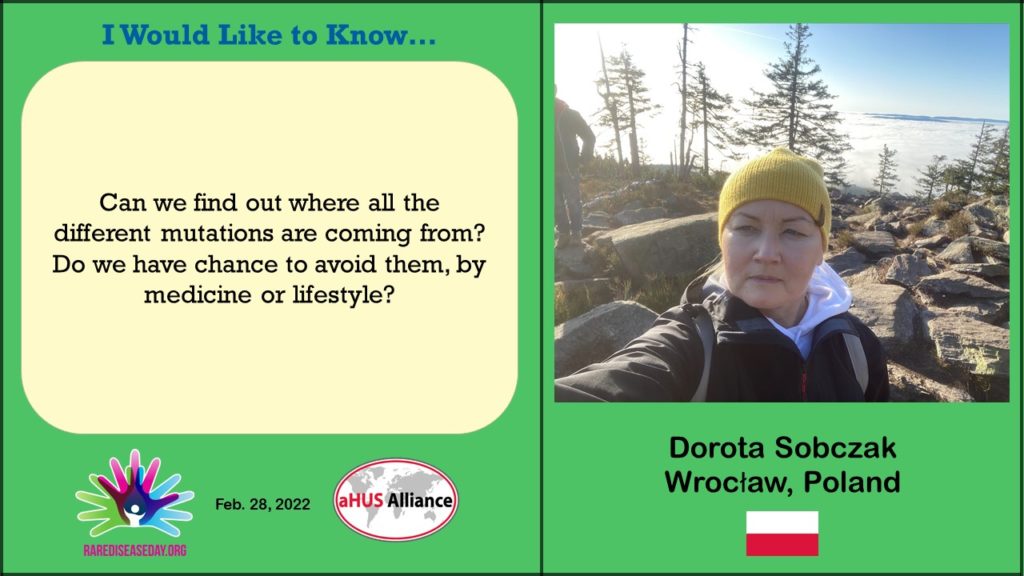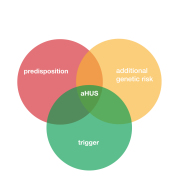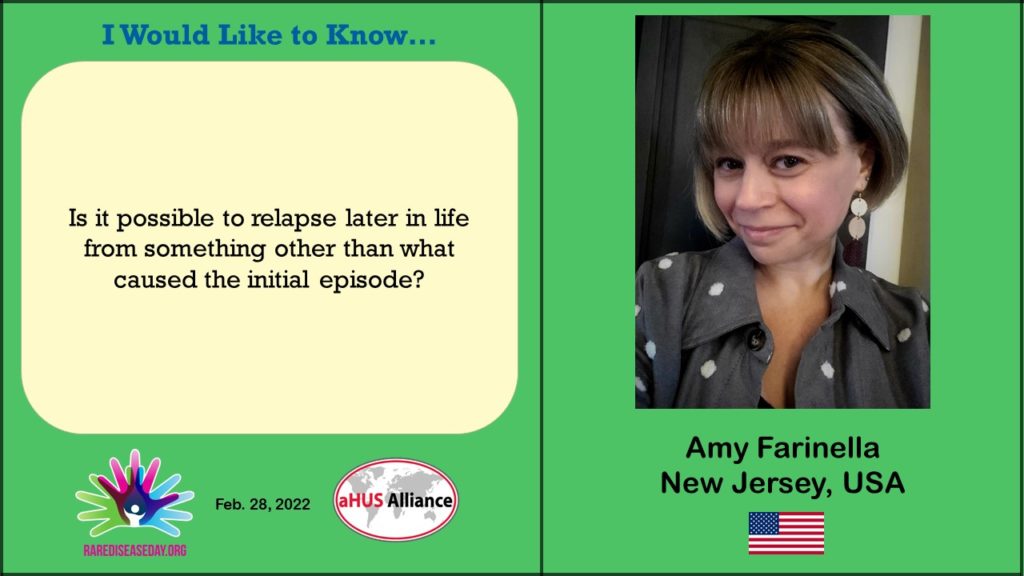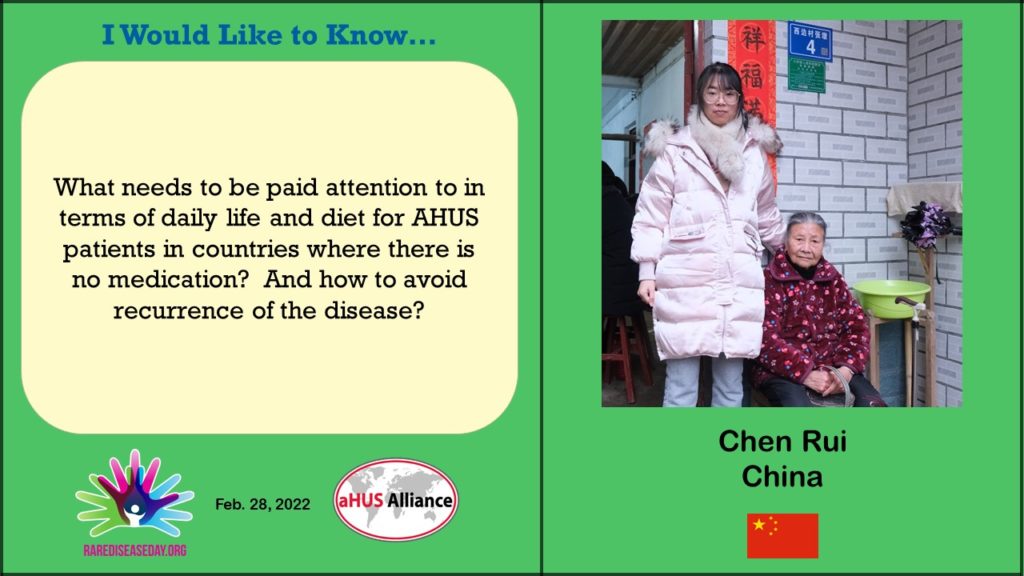It is known that certain rare genetic variants, mutations, or markers, in components of the Complement System make some people susceptible to aHUS. it is less known that there are more common genetic variants, or polymorphisms in doctor’s speak, which can modify the genetic risk of the rare genetic variants. They could explain why in some families where several members have the same rare mutation, some may onset and others do not. That fate is determined at conception and cannot be altered.

But as is illustrated in the Global Action’s “three circle ” model it also requires something else to trigger the over activation in aHUS, Dorota. An over activation that cannot be stopped because of the mutations in its Complement controls.The resulting damage done to self sends signals to the coagulation system which leads to the thrombotic microangiopathy (TMA) , which leads to the hemolysis, which in turn damages organs. The kidney in particular.

Lots of things can trigger aHUS and lots of them hit susceptible people many times at all stages of life ,Lisa. Without breaking through. Mostly infection triggers. But sometimes life time events or medical procedures like transplants can do it.
The most comprehensive list of triggers was created by Kavanagh et al and published nine years ago , see table below. The lists includes infections caused by bacteria or viruses, drugs, vaccination ,other medical conditions( including cancers) and even parasites ,

Other triggers have been spotted since. Reported as unusual aHUS trigger case studies.Even a viper snake bite has been reported to trigger aHUS
In the past two years Coronavirus Disease caused by the severe acute respiratory syndrome coronavirus 2
(SARS-CoV-2) , or most commonly called COVID-19 has been found to trigger aHUS. There has been one report of someone on-setting with aHUS soon after a COVID vaccination.
From the author’s family experience Methicillin-resistant Staphylococcus aureus or MRSA triggered an onset of aHUS while a family member, in his 70s, was in hospital for a routine procedure. I wrote an article* about him during the early days of the COVID-19 pandemic , which is relevant to this question too and well worth a read on its own. (After finishing this article , of course! )

How to avoid triggers is a difficult one, Chen. You will see my dilemma in the above article when facing a decision about flying abroad.
Triggers are a concern for those known to be genetically susceptible as well as those in remission.
As for foods, avoiding contaminated food and water would be prime way of avoiding risk. Anything high in salt another. Salt is implicated in high blood pressure over time and hypertension can be a trigger of aHUS.
Generally, the experience of COVID 19 shows how very particular attention to hygiene and social distancing can reduce the risk of infection. Any infection passed by airborne and/or suface contamination.
During COVID lock down case numbers for other infections like e.coli or influenza have fallen significantly. So maybe there has been less HUS and aHUS as a consequence.
Some viruses like CMV are ubiquitous in the population , 50% of people carry them . Although CMV can trigger a TMA, it very rarely does. Similarly with a less common but better known virus, HIV.
The life style changes needed to avoid other triggering conditions like cancers are well communicated but some conditions, such as autoimmune ones , will happen whatever personal behaviour is adopted.
Avoiding recreational drugs is sound advice for all and reminding doctors of your aHUS medical history when considering prescribing some drugs may avoid unnecessary harm.
Pregnancy is a triggering condition that can be prevented, though even the contraceptive pill is mentioned as a trigger in the Kavanagh list.
Over the years many people have experienced many triggering hits and not onset. Life has to go on. A balance needs to struck between taking unreasonable precautions and enjoying complete, but maybe reckless, freedom.
Also Chen , China is closer to having complement inhibitor treatment than maybe you think. Trials for new complement inhibitor treatments are going on there.
The 2013 table of triggers of aHUS known at the time
| Non-Stx toxin diarrheal illnesses | |
| Norovirus | 161, 162 |
| Campylobacter upsaliensis | 163 |
| Clostridium difficile | 164 |
| Respiratory infections | 51 |
| Bordetella pertussis infection | 10, 165 |
| Streptococcus pneumonia | 166 |
| Haemophilus influenzae | 10 |
| Other bacterial | |
| Fusobacterium necrophorum | 167 |
| Viral illnesses | |
| Varicella | 168 |
| Cytomegalovirus | 169 |
| Influenza H1N1 | 170 |
| Hepatitis A | 171 |
| Hepatitis C | 172 |
| Human immunodeficiency virus | 173 |
| Coxsackie B virus | 174 |
| Epstein–Barr virus | 175 |
| Dengue | 176 |
| HHV6 | 177 |
| Human parvovirus B19 | 178 |
| Parasites | |
| Plasmodium falciparum | 179 |
| Pregnancy | 51, 98, 180 |
| Drugs | |
| Cisplatin | 181 |
| Gemcitabine | 182 |
| Mitomycin | 183 |
| Clopidogrel | 184 |
| Quinine | 185, 186 |
| Interferon-alfa, -beta | 187, 188 |
| Anti–vascular endothelial growth factor | 189 |
| Campath | 190 |
| Cyclosporin tacrolimus | 191 |
| Ciprofloxacin | 192 |
| Oral contraceptives | 193, 194, 195 |
| Illicit drugs (eg, cocaine, heroin, ecstasy) | 196 |
| Autoimmune Diseases | |
| Anticardiolipin | 197 |
| C3Nef | 198 |
| Systemic lupus erythematosus | 199 |
| Vaccination | |
| Hepatitis B | 10 |
| Bone marrow transplantation | 200 |
| Malignancy (gastric, breast, prostate, lung, colon, ovarian, pancreatic, lymphoma) | 201 |
| Combined methylmalonic aciduria and homocystinuria |
Some recent publications about triggers of aHUS can be read in the website’s Info Centre at this LINK
Article No. 502

